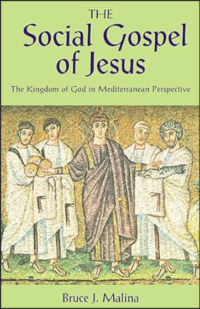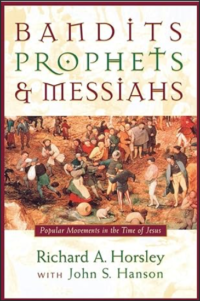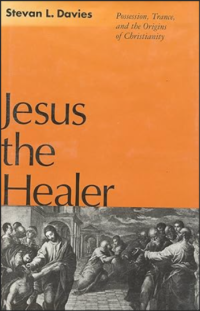Bruce J. Malina; Fortress Press; 2001.

by James A. Bacon
Of the few indisputable historical facts about Jesus, one is that he preached about “the kingdom of God.” The meaning of the phrase, which he illuminated by means of parable and simile, was clear, presumably, to 1st-century Galileans but it has engendered endless debate among 21st-century scholars. In his new book, The Social Gospel of Jesus, Bruce J. Malina sets two main goals for himself: to elucidate the social conditions which the kingdom of God was meant to address, and to explicate what Jesus and his contemporaries understood by the term.
A founding member of the Context Group, Malina has made a career of exploring the cultural and political context of the New Testament. His trademark has been the application of social-scientific models to 1st-century Mediterranean society. Dipping into the disciplines of anthropology, sociology and social psychology, he brings fresh insight to the kingdom-of-God controversy as well. The reader need not accept all of his conclusions in order to find this slender volume immensely stimulating. Malina introduces so many novel perspectives to an age-old issue that he could keep a cohort of graduate students busy for years fleshing out – or contesting — his views.
Malina’s core thesis is this: The traditional political system in Judea/Galilee was breaking down in the 1st century, disrupting the redistribution of wealth from the powerful to the weak. Ancient Mediterranean societies were organized around systems of patron-client relations. Influential and wealthy patrons formed personal, long-term relationships with weaker individuals, their clients. Typically, patrons bestowed wealth and favors in exchange for clients’ deference, support and acclaim. By means of such patron-client reciprocity, wealth trickled down the pyramids of power to much of the population. Under the influence of the imperial Roman system, however, Judean elites in the land of Israel abandoned their traditional roles as patrons, seeking instead to increase wealth by expanding their landholdings at the expense of freeholders[1] and to bolster their standing by building new cities, renovating new ones, and erecting new palaces and villas.[2]
The shift in elite priorities created a social problem, writes Malina: “For peasants in the region, the collapse of Israel’s patronage system meant tragedy in the face of recurrent peasant ills such as disease, accident, natural disasters, and early death, as well as mounting social ills due to peasant vulnerability, misfortune and land deprivation.”[3] Jesus’ kingdom of God would address the social problem by substituting a just and beneficent God in place of the Judean elites at the apex of the patron/client system. “Rescue from this situation could only occur with the God of Israel taking control of the country and restoring divine patronage.”[4]
In Chapter 1, Malina lays the groundwork by depicting the Mediterranean world under Roman rule as a “ruralized society,” a type of society governed according to the interests, values and concerns of large landowners. Refining this model, he draws an analogy to the Mafia and other southern Italian crime networks of the modern era: The coercive Romans ruled as “power syndicate” based on fear. Ancient Rome’s function “was to provide protection – occasionally genuine but more usually spurious protection from itself – in return for taxes and services. Roman government produced neither goods nor services for its subjects and milked legal and illegal businesses equally.”[5] Under the sway of the Romans, Malina suggests, Judean elites became far more predatory themselves: accumulating land holdings, levying heavier taxes, abandoning their obligations to the less fortunate – in sum, creating the social conditions that made Jesus’ kingdom-of-God message so appealing.
In Chapter 2, Malina introduces the concept of “vigilantism” as a form of establishment violence aimed at the maintenance of the status quo. Vigilante groups with the unofficial backing of the Judean elite arose to enforce prevailing values. Malina then brings in “deviance” theory, noting, “It is through battles with deviants that correct behavior is most sharply delineated.”[6] Jesus, he argues, can be seen as a particular type of deviant: a dissident, or one who challenges the prevailing interpretation of reality by employing the premises of the group, as opposed to an apostate, who employs different premises. Jesus conflicted with establishment groups by defining obedience to the Torah in ways that served his interests, not theirs, and by proclaiming the coming of a new theocracy that would overthrow the old. The reaction of the Pharisees, Temple priests and Jerusalem crowd, Malina says, indicate that “he usurped their moral values and placed their existence as a moral community in jeopardy.”[7] This challenge, he concludes, called forth a repressive, vigilante reaction that led to the cross.
In Chapter 3, Malina develops the argument that social interactions follow predictable patterns in complex agrarian societies like the Roman Empire. The Roman world ran according to the principles of patron-client relations. Economic and religious activity was embedded in kinship and politics. Market economics, in which goods were allocated by the price mechanism, applied to only a tiny percentage of transactions; exchange was governed overwhelmingly by the principles of familial and patron-client reciprocity. Likewise, religion was not conceived of as independent from other spheres of life. Domestic religion looked to the well being of the household, political religion to the health of the city or town, or, in the case of the Judeans, the entire ethnic group. “The scenario most befitting the story of Jesus is one of politically embedded religion,” Malina concludes. “Jesus proclaims his message, describes his task, and directs his symbolic actions at the pillars of politically embedded Israelite Yahwism. To proclaim the kingdom of God with God’s rule imminent is clearly a political statement in which religion is embedded.”[8]
Malina turns his attention in Chapter 4 to understanding the meaning of “rich” and “poor.” Although Jesus stated that “the poor” would inherit the earth, he did not understand the phrase the same way that moderns do, conditioned as we are to thinking of poverty as an economic condition. Excluding times of war, drought and famine, inhabitants of the ancient Mediterranean rarely lacked the means of subsistence, Malina contends. At the same time envy, or the evil eye, was omnipresent. Inhabitants of the Greco-Roman world had no concept of economic growth that made possible rising standards of living. They regarded all goods, from land and wealth to power and honor, as finite. Existence seemed a zero-sum game: If one person or group improved their condition, they did so at the expense of someone else. In such a frame of reference, people thought of the rich as evil – acquiring their wealth either by plundering or oppressing others, or by inheriting it from someone else who had. The poor, by contrast, were not necessarily thought of as virtuous but as people who had undergone a turn of misfortune. Interpreting the meaning of “poor” by means of linguistic collocation – or proximity to other words – Malina concludes in a tour de force:
The poor rank among those who cannot maintain their inherited status due to circumstances that befall them and their family, such as debt, being in a foreign land, sickness, death (widow), or some personal physical accident. Consequently, the poor would not be a permanent social class, but a sort of revolving class of people who unfortunately cannot maintain their inherited status. [9]
The poor included day laborers, landless peasants and beggars. It was not a lack of property that made them poor, however, but an inability to maintain their accustomed social status. The main value of wealth in the ancient world, Malina observes, was as a means to obtain honor. The status of being poor, he says, “referred to persons scarcely able to maintain their honor or dignity.”[10]
In Chapter 5, Malina explores differing motivations and personality types in collectivist and individualistic societies. “While individualists belong to many in-groups, yet with shallow attachments to all of them, collectivists are embedded in very few groups but are strongly attached to them,” he notes.[11] Consequently, it would have been difficult for followers of Jesus to maintain a primary loyalty both to their families and to his movement. Jesus’ call for the renunciation of traditional family ties, which modern observers often might find excessive or even bizarre, reflects the dynamics of a collectivist society.
Malina wraps up Social Gospel in Chapter 6 by focusing on how Jesus, his followers and early Christians conceptualized the kingdom of God. Jesus was presenting a solution to the social problem of an ineffective patronage system. As Malina explains, “The kingdom of God would prevail over the widespread ills generated by a malfunctioning political system. Jesus’ message urged Israelites to endure in the present and look forward to the forthcoming, new political theocracy where God would be Israel’s patron.”[12] One of Jesus’ innovations was to employ a kin-based metaphor for describing God’s relationship with Israel. Seeing himself as God’s “son,” he referred to the God as “the father” – the benign, patriarchal head of the house of Israel. Jesus did not interpret these relationships in a literal, biological sense; he was adopting the nomenclature of fictive kinship common in patronal societies. As the Jesus movement evolved after his death, it continued to embrace the fictive-kinship convention. Addressing one another as brothers and sisters, followers saw themselves as belonging to a “household of faith.”
The strength of Malina’s work is the abundance of fresh perspectives he brings to a well-worn subject. The weakness is that he offers disappointingly little concrete evidence to demonstrate his core thesis: that a breakdown in patron-client relations was occurring. Perhaps the Paradigm of Oppression has become so embedded in New Testament scholarship that Malina believes certain generalizations about socio-economic conditions in the Land of Israel need no justification. The conviction that social and economic conditions in the land of Israel were bad and getting worse – driven by increasing burdens of taxation, tithes, money lending, indebtedness and the expropriation of peasants’ land – has become the conventional wisdom of New Testament studies, at least in North America. Indeed, Malina’s Context Group colleagues deserve much of the credit for legitimizing and propagating this view.[13]
There is little hard evidence, however, either to support or refute the notion that money lenders were victimizing peasants on a large scale or that farmland was being concentrated in the hands of a few large estate owners.[14] Given the paucity of evidence, one can’t rule out Malina’s scenario, but one could argue with equal plausibility that the pax romana stimulated an unprecedented burst of economic growth and wealth creation in the land of Israel. The accompanying spread of a monetary economy corroded traditional social patterns, eroding reciprocity and mutual obligation among kin and neighbors in the villages, and creating new patterns of wealth and power in the upper levels of society. But in this alternate reading of the data, Jesus did not live in a world of intensifying impoverishment: He lived in a world of shifting fortunes that gave rise to new winners and losers. He appealed to those whose relative deprivation gave them the sense that evil and injustice reigned. Jesus’ message of the coming kingdom of God, one could argue, was addressed to those who felt unable to keep up.
I emphasize this point not to refute Malina’s thesis but to refine it. Growth and prosperity are just as likely as the factors that Malina cites to have engendered a breakdown of traditional patronage patterns. Furthermore, a model of “relative deprivation” dovetails nicely with Malina’s insight into it meant to be “poor” in 1st century Judea.
Jesus’ followers included not only the dispossessed but many persons of substance: Joanna wife of Herod’s steward, Mary Magdalene and other Galilean women who ministered to Jesus, Nicodemus and Joseph of Arimathea from the Jerusalem council, the sons of Zebedee the fisherman who hired servants to work in his boat, the Beloved Disciple who was known to the high priest, Lazarus and his sisters, and probably many others. Malina forces us to consider the possibility that the Galilean’s teaching resonated not only among landless laborers but among those whose personal experience had made them feel “poor” — unable to maintain their traditional privileged status – even though their contemporaries might well have considered them wealthy. In the expanding economy of the pax romana with its concomitant reshuffling of patterns of wealth, many among the privileged classes may have felt insecure about their ability to maintain their honor and dignity in face of the challenge posed by upwardly mobile newcomers. It is likely that Jesus spoke to Judeans across the socio-economic spectrum, not just to those at the bottom rungs.
In conclusion, Malina has introduced a provocative hypothesis regarding the social conditions that gave rise to Jesus’ message of the coming kingdom of God, but he does little to document it. That’s not to say he’s wrong – just that the limited evidence available can be read in more than one way. To make his hypothesis convincing, he needs to move beyond the elaboration of ideal types and social-scientific models, and spend more time marshalling the data from the Gospels, Josephus and archaeological digs to demonstrate how those models applied to the 1st-century Mediterranean world. But Malina apparently sees a different role for himself: He seems content to mine the social sciences for new perspectives and introduce them to the guild of New Testament scholars, then leave the follow-up work to others. As long as he jolts questors of the Historical Jesus out of their conventional modes of thinking, which he certainly has done in The Social Gospel of Jesus, he succeeds at what he set out to do.
— August 18, 2001
[1] P.32-33
[2] P. 141
[3] P.34
[4] P.35
[5] P.29
[6] P. 55
[7] P. 62
[8] P. 94
[9] P. 99
[10] P. 98
[11] P. 124
[12] P. 142
[13] In The Social Gospel of Jesus Malina cites mainly Douglas Oakman and K.C. Hanson, but Malina has worked closely with others, including Richard Rohrbaugh and William R. Herzog II, who have advanced similar perspectives.
[14] See Jack Pastor’s book Land and Economy in Ancient Palestine; Routledge; 1997. Pastor argues for the persistence of the same land-tenure patterns – the co-existence of monarchical lands, large estates and small farms — through successive political regimes: the Persians, Ptolemies, Seleucids, Hasmonaeans, Herod the Great and the Romans. There is insufficient data, he says, to conclude how the proportion of each category changed over the years.



